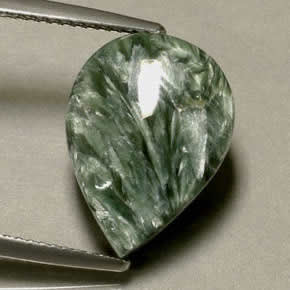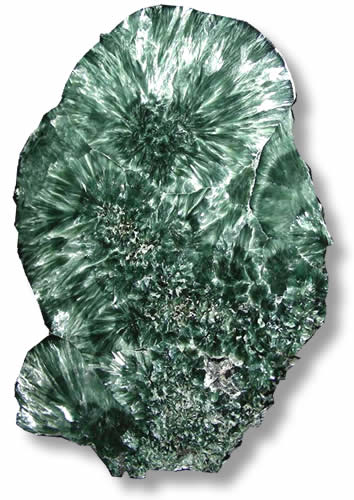Green Seraphinite Gemstones

Natural Seraphinite
Seraphinite is a trade name for a particular form of clinochlore, a member of the chlorite group. The dark green color of seraphinite is enhanced by a silvery and feathery shimmer caused by mica inclusions. The name, 'seraphinite' comes from a Greek word, seraphim, meaning a winged heavenly being, because of the feather-like appearance of the chatoyant fibers in the stone.
The chlorites are a group of phyllosilicate minerals. The name comes from the Greek word for green, chloros, since most chlorites are green, though they also occur in white, yellow, red, lavender or black. The most common chlorite varieties are clinoclore, pennantite and chamosite. There are only two gem-quality minerals in the chlorite group, both types of clinochlore: Seraphinite and kammererite.
The mineral clinochlore was first identified in 1851 in West Chester, Pennsylvania. It has since been discovered in a number of other locales in the USA, including New York, Arizona and New Jersey. Clinochlore can also be found in other countries, including Spain, Switzerland, Russia, Turkey and Italy.

Seraphinite Rough
Seraphinite, like the other clinochlorites, is magnesium iron aluminum silicate hyroxide. It is quite a soft stone, with a hardness of only 2 to 2.5 on the Mohs scale. Like all the chlorites, seraphinite exhibits perfect cleavage in one direction. When polished, seraphinite displays a pearly to vitreous luster. It has a density of 2.55 to 2.75, which is approximately the same range as quartz or beryl. Its refractive index is 1.576 to 1.599, similar to emerald and aquamarine.
Due to its softness, seraphinite is mainly a collector's stone. What makes it of special interest is the silvery chatoyant fibers, which form patterns similar to feathers.
The romantic name and the association of seraphinite with angels has gained seraphinite a reputation as a healing gem that is good for nerves and brain cells.
|
